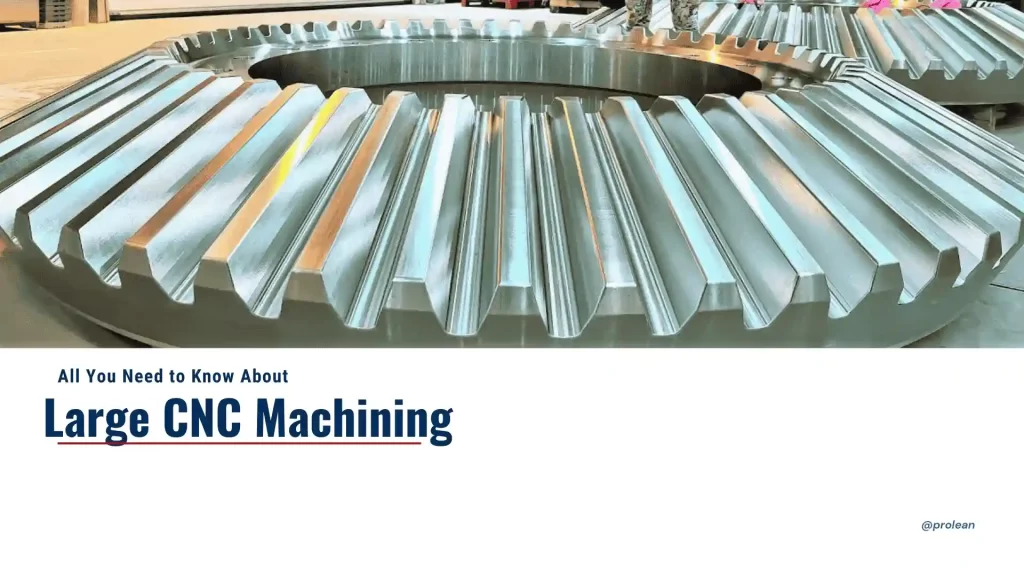
Large CNC Machining
Machining large parts or components presents challenges with traditional techniques. These components demand large size, weight, and complexity beyond the capacity of conventional machines.
However, this problem is resolved with the use of large CNC machining. These machines can produce oversized parts precisely. Mining, agriculture, construction, oil, and gas industries rely on these large machines for heavy-duty and precision-demanding components.
Large CNC machining can machine parts that weigh up to 30-50 tons and have extra-large diameters. Engineers can also take test runs and trials with the rapid prototyping process to reduce material waste and production costs later.
Large scale machining must not be misunderstood based only on its size range. You need to emphasize the actual parts involved, how complex the design is, how the machine will be set up, and the tolerance requirements.
This guide will explain all about large CNC machining, its applications, design considerations, and how to plan efficient machining of large parts.
What Is Large CNC Machining?
Large CNC Machine
Large precision machining allows you to make larger components and achieve tight tolerances. These machines can process a few inches or several meters. Aerospace, automotive, construction, and heavy machinery utilize these machines to create parts that could not be manufactured using conventional techniques.
The process is subtractive, cutting material out of the block using a computer-controlled method. Large pieces need meticulous planning for every cut, as well as small-scale CNC operations. The tool used, machine setup, and handling of the workpiece are essential for eliminating errors that might prove expensive in terms of material and time.
Large CNC machines allow the production of complicated shapes and intricate features up to a gigantic size. Pre-simulation: pre-production simulations aid in the detection of possible issues, cutting paths, and waste reductions. When set up correctly, you can achieve tight tolerances and quality finishes so that every part can be used to the exact requirements of its functionality. (See also: additive manufacturing)
Specifications of CNC Machines for Large Components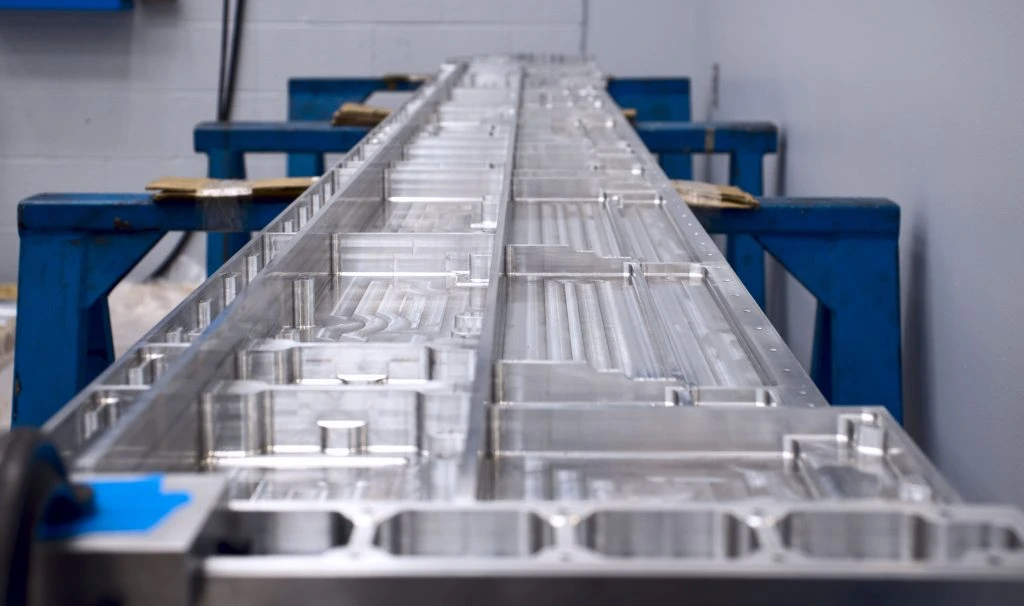
Large CNC Machined Part
Large component machining utilizes large specialized machines dealing with oversized parts. These machines comprise unique capabilities based on the size, shape, and material. Horizontal and vertical machining centres, CNC lathes, and gantry mills are used in turning, milling, drilling, and boring operations.
A proper machine choice is quite necessary. Generally, long, heavy workpieces and high-torque operations can be accommodated using:
- Horizontal Machining Centres (HMCs)
For milling and finishing the surface details, the best choice is:
- Vertical Machining Centres (VMCs)
When you need cylindrical components, turning, threading, and contouring are to be undertaken. Then,
- CNC Lathe is an optimal choice
For the largest working enveloped parts that undergo additional processing procedures, such as welding, heating, and assembly.
- Ganty mills are ideal.
Through cautious machine selection, tool setting, and thorough planning, quality outcomes and repeat performance are certain in large component production. (Read more about Milling Machine Vs. Lathe)
The table below summarises key specifications and capabilities of typical large part machines used in industry:
| Machine Type | Bed Dimensions (L x W x H) | Maximum Workpiece Diameter | Maximum Part Length | Key Capabilities |
| Horizontal Machining Centre | 5.2 m x 3.1 m x 2.1 m | 2.1 m | 5.5 m | Heavy-duty milling, high-torque drilling, and boring operations |
| Vertical Machining Centre | 3.2 m x 2.1 m x 1.6 m | 2 m | 3.2 m | Precision milling, detailed drilling, surface finishing |
| CNC Lathe | 4.1 m x 1.6 m | 1.6 m | 4.2 m | Turning, facing, threading, and contouring of cylindrical parts |
| Gantry Mill | 6.2 m x 4.1 m x 2.6 m | 3.2 m | 6.5 m | Large-scale milling, heavy fabrication, and machining of structural components |
Try Prolean Now!
The Large CNC Machining Process
Large part machining requires a well-organized procedure. Several critical steps are undertaken to validate accuracy and effectiveness. These steps assist the engineers and operators in dealing with large-scale machining. Here’s a breakdown of each step.
CAD in problem-solving
The initial process is drawing up a complete part model with the help of CAD software. This model may be 3D or 2D, depending on the complexity of the component. The design emphasizes necessary measures.
- Threads
- Tolerances
- Reference lines
A designed CAD model directs the operator and makes the part ready to be machined accurately.
CAD Designs to CNC Compatible Code conversion
The CNC machines cannot directly read CAD files. These files are converted into CAM (Computer-Aided Manufacturing) software to generate toolpaths and G-code to create instructions about which sequences of cuts are to be passed, and machine moves. It also establishes parameters like the feed rate and the number of spindle rotations.
Tooling and Workpiece Preparation
Once the code is ready, the next step is to choose the right material and machine. This involves ascertaining the appropriate CNC machine and tools and setting up operations regarding the part requirements. The machine choice varies according to the
- Size
- Part/Component Complexity
- Material Characteristics
Correct workpiece positioning and proper clamping are essential to avoid machining errors.
Automated Part Generation
The last step is commencing the machining process. Engineers evaluate everything and ensure that all tools are correctly installed and the workpiece is firmly clamped. When everything is in place, the program is run on the machine. The machine shapes the part according to the CAD design, and the final part maintains high accuracy and is finished at this phase.
Useful Tips for Handling Large Part Machining
Machining oversized components must be planned out, and details must be considered. These parts often involve challenges that are not experienced on a standard-sized part. The sooner these issues are rectified, the less time wasted, fewer mistakes, and the better the expected result.
Multiple Setup Planning
Large parts frequently involve multiple machining setups. The various setup positions allow access to different areas of parts, and give the ability to produce certain features. It is essential to maintain uniform alignment with each setup so that the features of different stages fit as intended. The lack of proper alignment may lead to inaccuracies, the wasting of material, and extra effort.
Controlling Size and Weight
The weight and size of a part may restrict the machining available. The part should be cut into parts when it is oversized to fit the machine enclosures. The weight limits, such as the fixturing necessary to hold the part in place. It is also possible that tall or heavy parts cannot fit safely under the machine, so the design may not be practically used.
Tool Availability
A lack of specialized tools usually characterizes large part machining. Most machines and standard tools are more appropriate for the smaller parts. With even large CNC machines, human skills are needed in some of the operations. This may slow down production and increase labour expenses.
Maintaining Accuracy
Achieving high precision comes with challenges in machining large parts and multi-setup setups. Operators must offset thermal expansion and closely watch cutting parameters to achieve quality throughout the part.
Design-Phase Considerations
It can be easy to machine and assemble large parts into smaller ones. Modular sections may be produced in many sizes and weight constraints if the customer allows. It is also essential to select the correct type of machine. Certain lathe operations have traditionally been performed on a 4-axis mill, providing new opportunities and easier access to some complex shapes.
Advanced CAD software helps plan the best machine and set up for each job. It makes the process efficient, minimizes mistakes, and produces a high-quality part.
Applications of Large CNC Machining
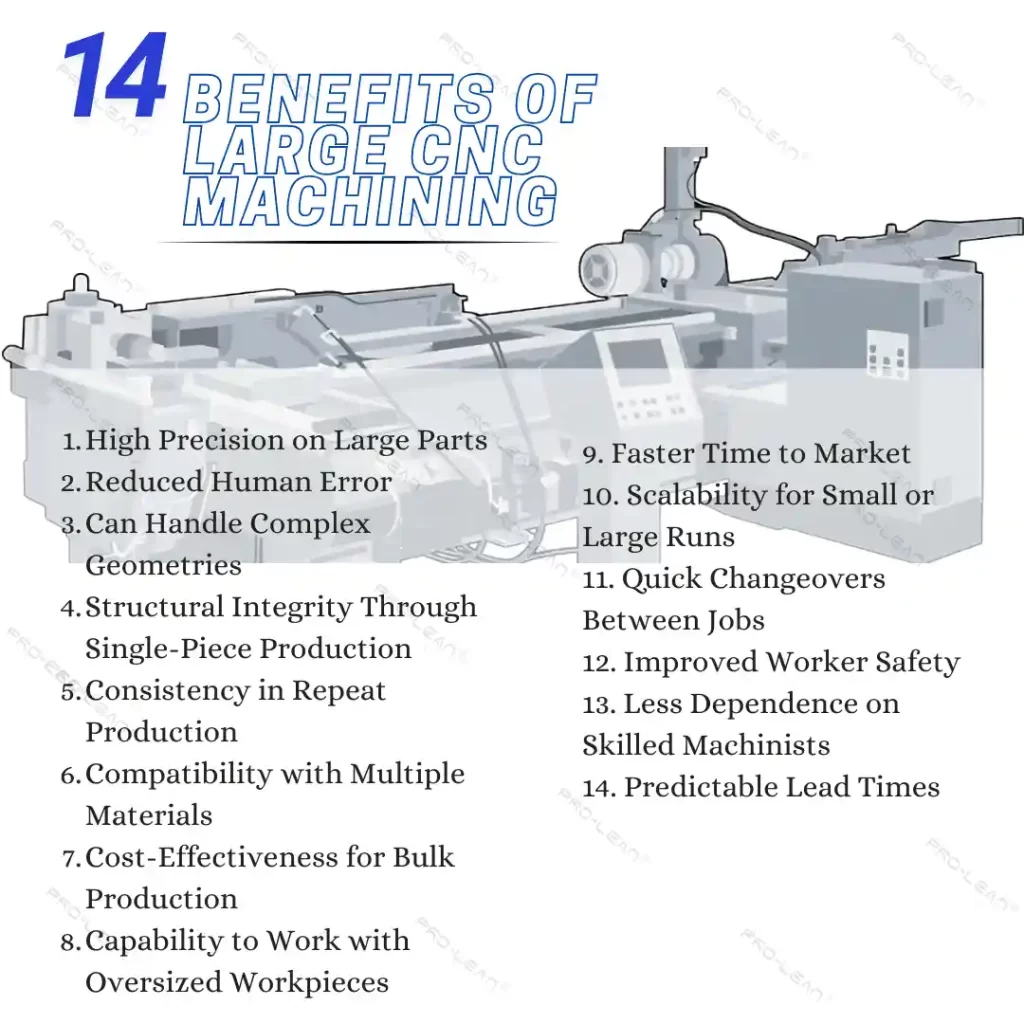
Benefits of Large CNC Machining
Large CNC machining services industries that depend on heavy-duty and high-precision parts. For example, it serves the best automotive, aerospace, energy, and electronics industries.
Automotive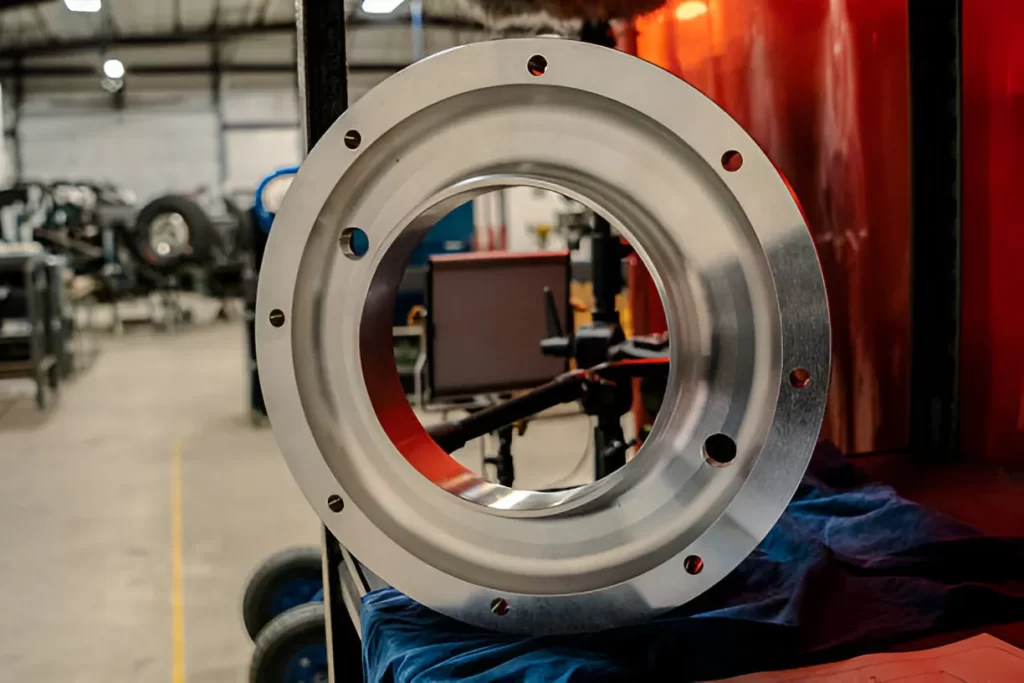
CNC Machined Flanged Metal Ring
Large part CNC machining applies to automotive parts such as engines, shafts, cylinder heads, and gearboxes. The process provides uniform quality and meets near-closed tolerances in all the parts.
Aerospace
The aerospace parts demand high precision for optimal performance and flight safety. Large CNC machining manufactures fuselage pieces, wing spars, and landing gear assemblies. It also promotes the manufacture of substitute components and upgrades.
Power Generation and Energy
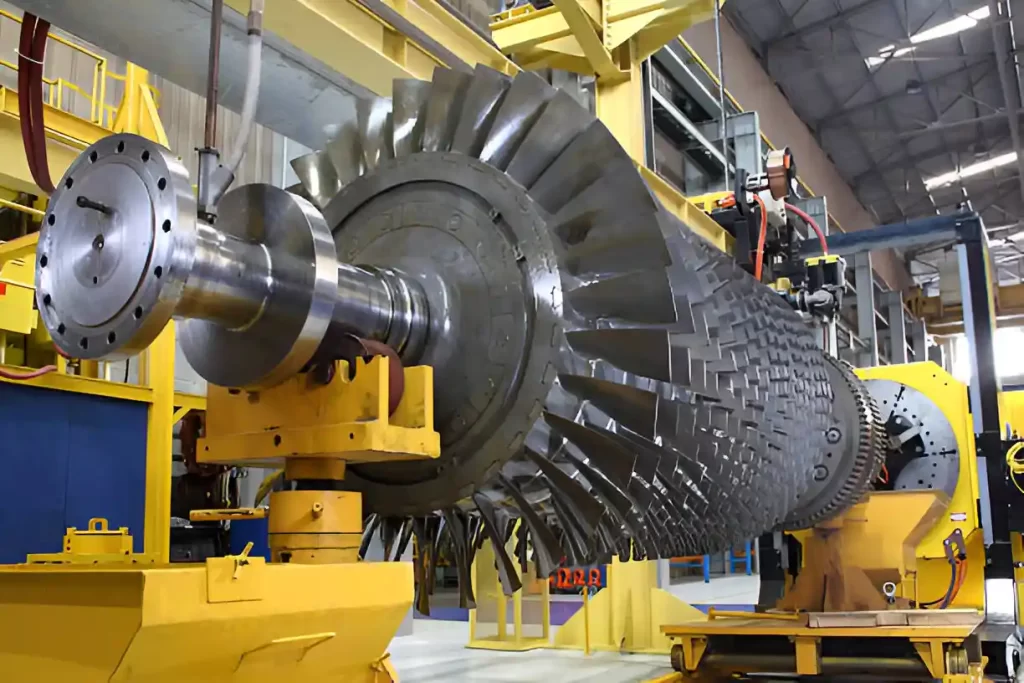
Gas turbine rotor at workshop
In turbines, engines, and power-generating machinery components. CNC machines ensure that parts are rigid to withstand operational stresses without dimensional variation.
Mining
The mining machinery is highly dependent on strong, heavy-duty parts. Large CNC machines manufacture gear racks, ranging arms, and gearboxes. These components have to resist continuous working and severe conditions.
Oil and Gas
Oil and gas equipment are usually subject to high pressure. Large CNC machining manufactures rig parts, fracking pumps, and connecting rods.
Try Prolean Now!
Types of CNC Machines for Large Parts Machining
Machining large parts requires machines constructed with strength, accuracy, and stability. Different types of CNC machines possess certain benefits depending on the part’s size, shape, and material. The selection of the appropriate machine dictates accuracy, efficiency, and safety.
Horizontal Machining Centres
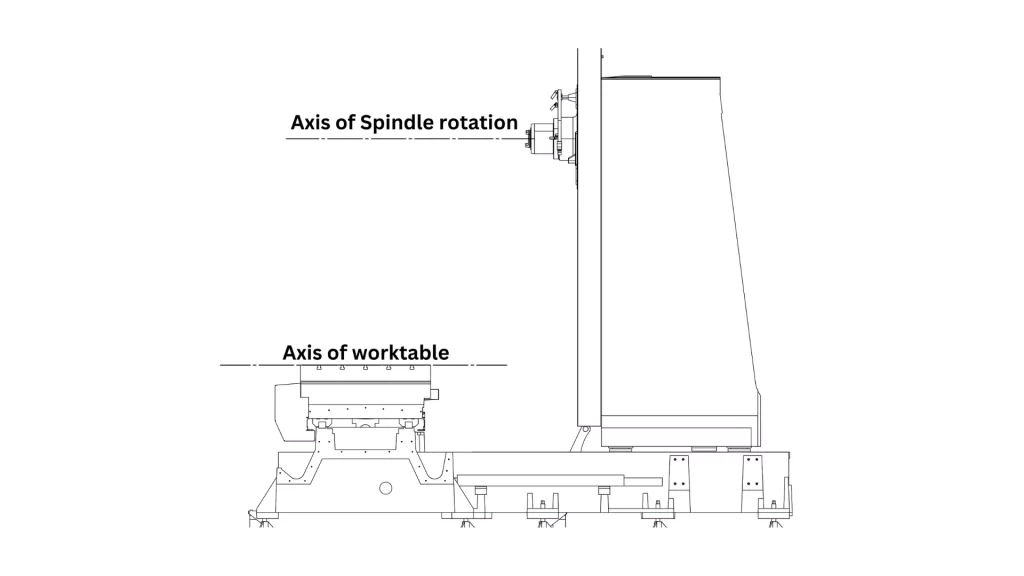
Horizontal Machining Center Illustration
The heavy parts of turbine casings and structural frames can be machined on their large beds that are usually more than 15 square metres in area. Their high-torque spindles and multi-axis make them well-suited to milling, boring, and drilling on more complex geometries.
The machines are popular in aerospace and industrial applications due to their accuracy and large and intricate piece handling capability. They are made to stabilize even when great cutting forces are present.
Large Parts Vertical Machining Centres
Vertical Machining Center
The vertical machining centres are vertically positioned, and they move multi-axially. These are perfect when it comes to milling, drilling, and finishing of parts with complicated shapes. Bed areas up to six square metres, coupled with high-speed spindles to achieve a high standard of surface finish.
These are frequently applied in the aerospace and automotive industries. They hold narrow tolerances even on large parts, and can work on parts that need complex geometries without reducing the accuracy.
CNC Lathes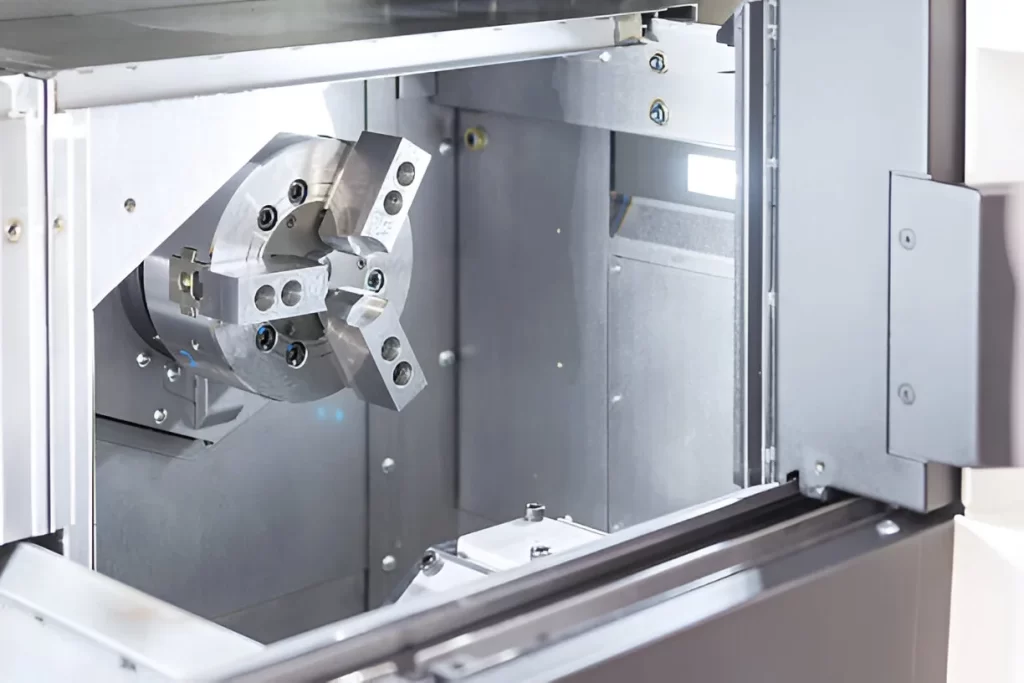
CNC Lathe Chuck
CNC lathes rotate the job piece, and a cutting tool removes some of the material. Large-scale lathes today include multi-axis and live-tool functions and can cut parts many metres in length or width.
They are most suited to cylindrical objects, e.g., shafts, rollers, and pins in transport, oil and gas, and heavy mechanisms. Large CNC lathes can process materials like cast iron and stainless steel that expand when heated. These also support thread, face, and finish surfaces.
Gantry Mills
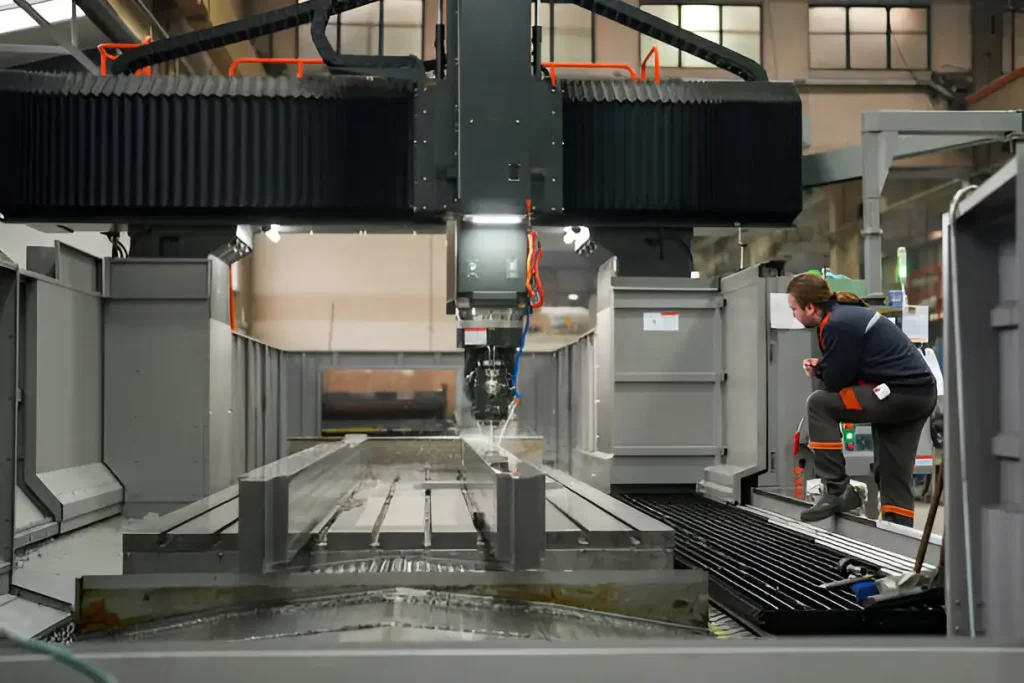
Gantry Mill
Gantry mills provide a rigid structure that supports large and heavy parts using a gantry structure. The bed area is up to 20 square metres, which allows the machining of several tons of parts.
The machines, such as mining and large industrial machinery parts, are used for heavy milling and fabrication. Their long travel and multi-axis features provide accuracy on large workpieces and bring rigidity to cutting.
Machining Materials Used in Large CNC Machining
Large CNC machining can work with many different materials. The choice depends on the part’s strength requirements, weight, and the environment in which it will operate. Using the right material ensures the component performs reliably.
| Material | Properties | Common Use |
| Steel | Strong and durable | Construction, oil, and gas parts |
| Stainless Steel | Resistant to corrosion, highly strong | Industrial machinery, heavy components |
| Aluminum | Lightweight, easy to form | Aerospace, transport components |
| Cast Iron | Dampens vibration, machinable | Machine bases, industrial equipment |
| Titanium | Heat-resistant, very strong | Aerospace, defence parts |
| High-Strength Plastics | Lightweight, durable | Automotive parts, systems needing metal alternatives |
Prolean’s Large Part CNC Machining Capabilities
Prolean Tech uses CNC machines to produce large parts accurately and efficiently. Oversized parts with demanding tolerances and quality finishes can be machined using our horizontal and vertical mills, lathes, and multi-axis machines.
We also offer ancillary services like assembly, heat treatment, welding, hardening, and machining. This implies you can get all services under the same roof, reducing delays and easing your project processes.
Contact Prolean if you need CNC machining services for large-sized parts/components. Our team is always ready and committed to providing accuracy, reliability, and on-time deliveries. We ensure you get standard-quality components that match your design specifications and perform as intended.

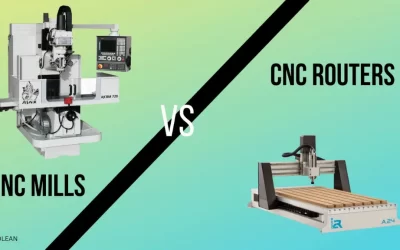
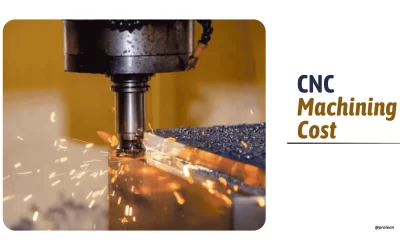
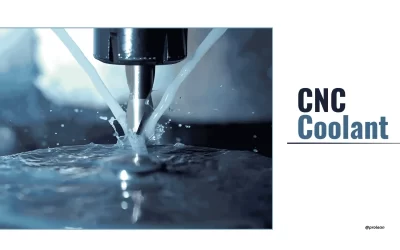
0 Comments